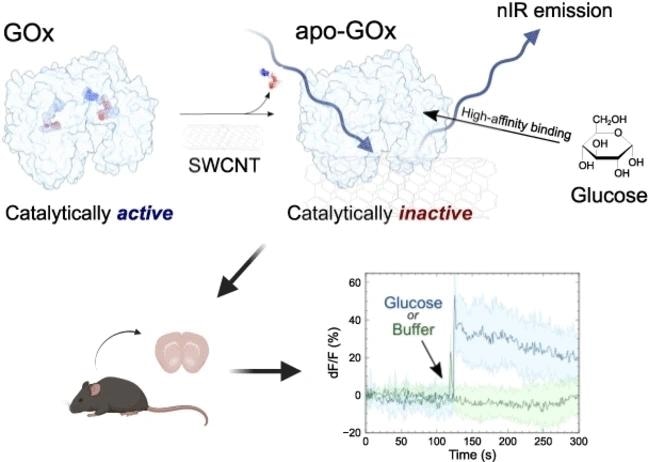Glucose monitoring is one of the most important components of health monitoring. Recently, a group of scientists created a fluorescent nanosensor that requires no batteries and comprises single-wall carbon nanotubes and an inactive version of the enzyme glucose oxidase (GOx). The findings were reported in Angewandte Chemie.

Image Credit: Angewandte Chemie
The authors detail that continuous, reversible, and non-invasive bioimaging of glucose levels in bodily fluids and tissues is achievable since the enzyme is not in its active state, preventing the analyte from being consumed during the measurement.
GOx-based electrochemical sensors are commonly utilized for measuring blood glucose levels. But these sensors also require large electrical circuits and batteries, which makes it challenging to create implanted devices for continuous monitoring. They also emit deadly hydrogen peroxide as a byproduct.
On the other hand, small SWCNTs can be incorporated into tissues and offer bioimaging data. SWCNTs emit a near-infrared fluorescence signal when stimulated by light, which passes through the tissue and is easy to record using non-invasive bioimaging methods.
Unfortunately, the most efficient method for loading molecules onto SWCNTs—sonication—essentially renders the GOx molecules inactive, making the development of GOx-based SWCNT nanosensors challenging. According to Markita P. Landry and her research group at the University of California, Berkeley, USA, the idea that active GOx is necessary for GOx-based sensors to detect glucose has now been refuted.
They synthesized GOx-loaded SWCNT sensors by sonication, which enabled them to quantify glucose in serum, plasma, and mouse brain slices with sensitivity, selectivity, and reliability.
The capacity of the dormant GOx enzyme to bind glucose without converting it provided the researchers with an explanation for this unexpected discovery. Modulating the fluorescence signal just required binding.
The scientists even created a GOx enzyme without the reactive group needed to convert glucose, so it would be totally independent of GOx activity. As dependable as the first conjugate of SWCNT and natural GOx, the apo-GOx-SWCNT sensor was able to detect glucose in bodily fluids and mouse brain slices.
The researchers highlight certain significant benefits associated with dormant GOx molecules. For instance, sonication is an efficient preparatory step that can simplify the GOx-SWCNT nanosensors’ production process. Not only are the readings intrinsically reversible and the analyte not consumed by the enzyme process, but they also result in no harmful byproducts and enable non-invasive continuous glucose monitoring in tissue fluids.
Journal Reference:
Nishitani, S., et. al. (2023) Engineered Glucose Oxidase-Carbon Nanotube Conjugates for Tissue-Translatable Glucose Nanosensors. Angewandte Chemie. doi:10.1002/anie.202311476